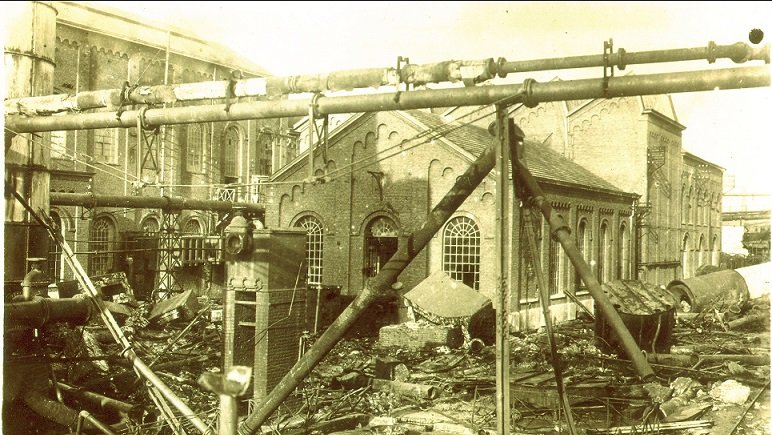History of a bank: The Great War
War broke out at a time when Société Générale de Belgique (later re-named Generale Bank) and Algemene Spaar- en Lijfrentekas / Caisse Générale d’Épargne et de Retraite were enjoying a highly prosperous period.
During the four years of hostilities, these two forerunners of BNP Paribas Fortis were to play a major role in society, especially in organising food supplies for Belgium.
August 1914 – Following the assassination in Sarajevo on 28 June 1914, the whole of Europe was engulfed in war within the space of a few weeks. Belgium, although a neutral state, was immediately drawn into the conflict.
On 4 August, the German army invaded Belgium. The Liège forts stood as the first obstacle on the path towards Pa¬ris. Their heroic resistance effectively saved France and Great Britain from a military disaster. The invaders’ response was to unleash a wave of terror against the population. Between 5 and 26 August 1914, the Germans killed 6,500 Belgian civilians and destroyed over 20,000 dwellings.
Food aid – Cut off from the countries which usually supplied their needs, the Belgian population was very soon threatened with famine. In September 1914, a group of businessmen founded the Brussels Central Committee for Food Relief, which set about cataloguing the available resources and organising their distribution. In October, this initiative was extended to the whole country with the establishment of the National Committee for Food Relief (French acronym CNSA). Coordinated by Emile Francqui, a director of Société Générale de Belgique, the CNSA obtained authorisation from the German and British authorities to import food supplies into occupied Belgium under the surveillance of three neutral countries – the United States, Spain and the Netherlands. Next, a body entirely separate from the CNSA was set up. This Commission for Relief in Belgium (CRB) gathered funds, purchased foodstuffs, organised their transportation to the ports of Rotterdam and Antwerp, and ensured that they were not requisitioned by the German forces. Financed by the Belgian government and through private donations, the CNSA managed to feed eight million people – inhabitants of Northern France who were cut off from the rest of their country by the military front line as well as native Belgians. Société Générale de Belgique and its subsidiaries lent considerable support to this humanitarian operation, with donations and interest-free advances and by placing the services of its staff at the disposal of the Committee.
Banking and financial activities – In June 1914, as the government announced a general mobilisation, people rushed to the counters of ASLK-CGER* to withdraw their savings. To avoid a mass run on the banks, the Finance Ministry froze all negotiable instruments and placed restrictions on cash withdrawals.
After the financial panic of the first few days, people quickly stopped withdrawing their deposits and soon the very opposite began to happen: business began to dry up, companies and merchants could no longer find opportunities to invest their cash flow, so they entrusted their spare funds to financial institutions. Some of these copious deposits were used to discount the bills issued to finance the food aid operation and also helped to finance the local authorities, whose residents were now falling into poverty.
Industrial activity – During the summer of 1915, Jean Jadot, Governor of Société Générale de Belgique, asked the German authorities to authorise Belgium to impor¬t raw materials to supply the country’s manufacturers. Germany gave an undertaking not to confiscate either these raw materials or the finished manufactured good that were destined for export to neutral countries.
Unfortunately, these plans never came to fruition. Deportations continued and industrial activity declined rapidly. By the end of the war more than 600,000 workers were unemployed.
International contacts – In 1914, Société Générale de Belgique possessed a network of 21 subsidiary banks which did business not only in Belgium but also in the Congo, China, Egypt, the UK and Latin America.
The German occupation rendered relations with these subsidiaries extremely difficult. During this time, Edmond Carton de Wiart ran the international operations of Société Générale from London.
Peace and Reconstruction – When the armistice finally came on 11 November 1918, Société Générale de Belgique was faced with a country in need of national reconstruction. For the next years, the bank displayed prodigious energy. Société Générale helped to set up new companies, taking major stakes in firms such as the electrical group Ateliers de Constructions Electriques de Charleroi (ACEC) and the railway business Société des Wagons-Lits, and providing guarantees to Belgian and Luxembourg-based companies, thus enabling them to consolidate their debts, replace machinery that had been removed by the occupying forces and re-equip their factories.
* At that time, ASLK-CGER operated all over Belgium through branches of the National Bank and the post offices.
View our photo collection from the period.
History of a bank – This article is the fourth in the ‘History of a bank’ series, in which BNP Paribas Fortis offers the reader stories and anecdotes on various events in our economic and social history. View previous articles:
The first woman at the bank and the evolution of the role of women in the world of work
Paid leave in Belgium, from privilege to right
Building the Beijing - Hankou railway on the eve of the 20th century
Consult the BNP Paribas Fortis archives – Would you like to consult, reproduce or publish excerpts from the archives of BNP Paribas Fortis forerunner banks such as Société Générale de Belgique, Generale Bank, ASLK-CGER or Crédit à l’Industrie – Krediet aan de Nijverheid?
Send a mail to historicalarchives@bnpparibasfortis.com to arrange an appointment.
Our archives are managed by the BNP Paribas Fortis Historical Centre, located at 2 rue des Sols, 1000 Brussels, just opposite the Central Station.
- BNP Paribas Fortis
- CSR
- Corporate Social Responsibility
